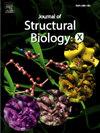Snake venom defensins: Defining the structural and functional characteristics of the toxin family
IF 5.1
Q2 BIOCHEMISTRY & MOLECULAR BIOLOGY
引用次数: 0
Abstract
Snake venom defensins are a toxin family found in rattlesnake venoms (Crotalus) which are comprised of crotamine-like peptides and myotoxins. Their tertiary structure resembles the β-defensin family structure. Toxins from this family, such as crotamine (C. durissus terrificus) and myotoxin a (C. viridis viridis), have been described to generate paralysis through Kv 1.3 channel blockade, using three functional basic-hydrophobic dyads (Y-K, R-W, and R-W). However, the structural and functional properties of other snake venom defensins are scarcely described. For that reason, we evaluated the structural–functional characteristics of the rattlesnake venom defensins on the Kv 1.3 channel through in silico analysis. 38 snake venom defensins were found to be peptides from 41 to 48 residues with a highly conserved sequence. The three-dimensional structures had great similitude (RMSD, <1.1 Å). Moreover, molecular dynamics simulations showed that the structures were stable (0.445 ± 0.23 nm). It was found that the snake venom defensins contain two or three basic-hydrophobic dyads, the first one is present in the N-terminal region of the defensin comprised by YK. The dyads two and three are contiguous, forming a motif in the γ-core, of which there are seven phenotypes: RWKW, RWRW, PWRR, PWKR, RWKR, RLGW, and GWRR. These dyads played a key role in the interaction of the defensins with the pore residues of the Kv1.3 channel. These results demonstrated that snake venom defensins have common structural and functional properties, interacting with the Kv 1.3 channel through the basic-hydrophobic dyads.

蛇毒防御素:定义毒素家族的结构和功能特征
蛇毒防御素是在响尾蛇毒液(Crotalus)中发现的一种毒素家族,由crotamine样肽和肌毒素组成。它们的三级结构类似于β-防御素家族结构。来自该家族的毒素,如crotamine (c.d urissus terrificus)和myotoxin a (c.v iridis viridis),已被描述为通过kv1.3通道阻断,使用三个功能性碱性疏水二联体(Y-K, R-W和R-W)产生瘫痪。然而,其他蛇毒防御素的结构和功能特性很少被描述。为此,我们通过计算机分析评估了响尾蛇毒液防御系统在Kv 1.3通道上的结构功能特征。从41 ~ 48个残基中发现了38种具有高度保守序列的蛇毒防御素。三维结构具有很好的相似性(RMSD, <1.1 Å)。分子动力学模拟结果表明,结构稳定(0.445±0.23 nm)。研究发现,蛇毒防御素含有2 ~ 3个碱性疏水二联体,第一个存在于由YK组成的防御素的n端区域。二对体2和二对体3相邻,在γ核中形成一个基序,其中有7种表型:RWKW、RWRW、PWRR、PWKR、RWKR、RLGW和GWRR。这些二联体在防御蛋白与Kv1.3通道孔残基的相互作用中发挥了关键作用。这些结果表明,蛇毒防御素具有共同的结构和功能特性,通过碱性疏水二偶体与Kv 1.3通道相互作用。
本文章由计算机程序翻译,如有差异,请以英文原文为准。
求助全文
约1分钟内获得全文
求助全文
来源期刊

Journal of Structural Biology: X
Biochemistry, Genetics and Molecular Biology-Structural Biology
CiteScore
6.50
自引率
0.00%
发文量
20
审稿时长
62 days
 求助内容:
求助内容: 应助结果提醒方式:
应助结果提醒方式:


